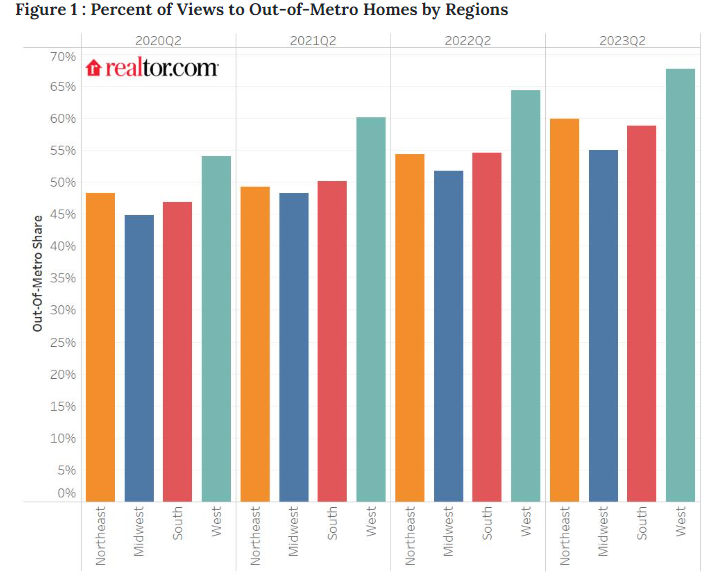 According to an analysis of for-sale listings on the Realtor.com marketplace in the Top 100 metros between April and June 2023, more shoppers are looking for homes in areas other than where they live. In Q2 of 2023, an average of 60.3% of all Realtor.com listing page views from the top 100 metros went to homes located outside the metropolitan areas where shoppers live, indicating that Americans are on the move. This was an increase of 0.7 percentage points from the first quarter of 2023 and an increase of 4.1 percentage points year-over-year.
According to an analysis of for-sale listings on the Realtor.com marketplace in the Top 100 metros between April and June 2023, more shoppers are looking for homes in areas other than where they live. In Q2 of 2023, an average of 60.3% of all Realtor.com listing page views from the top 100 metros went to homes located outside the metropolitan areas where shoppers live, indicating that Americans are on the move. This was an increase of 0.7 percentage points from the first quarter of 2023 and an increase of 4.1 percentage points year-over-year.
The findings, assembled by Jiayi Xu, Economist for Realtor.com, found that in Q2, Western home shoppers were most likely to look for out-of-market homes, but Northeastern shoppers are catching up. The cross-market shopping share in the Northeast saw the highest growth in Q2, when the share was 5.5 percentage points higher than the prior year.
At 67.7% of out-of-metro views, home shoppers from the West outperformed their peers and became the group that are most likely to search for out-of-metro homes. Because the West has consistently had the largest share of home shoppers looking elsewhere, it saw relatively low year-over-year change in out-of-market home searching.

In an analysis of long-distance home searching trends, sometimes unexpected cities were paired up. Cross-market interest such as from San Francisco to Chicago and Chicago to Dallas, have been consistently observed over the past four quarters.
San Francisco’s metro pair was found to be Chicago, with the Windy City ranking as the top out-of-state destination for home shoppers based in San Francisco for the past four quarters. This might be surprising considering the difference between the two places. However, their similar industry structures and relatively affordable housing markets could be attractive enough to entice people to move from San Francisco to Chicago. Both metros serve as important tech hubs, as Census data, found that tech workers in San Francisco and Chicago accounted for 7.7% and 3.4% of tech labor in the country, respectively, ranking first and ninth. Additionally, both metros serve as hubs for air transportation, with employees in the air transportation industry in San Francisco and Chicago comprising 4.2% and 6.2% of total air transportation employees in the U.S., respectively, ranking eighth and fourth. The homeownership rate in Chicago was reported to be 65.1% in Q2, significantly higher than the rate of 55.2% in San Francisco.
The Dallas area served as the metro pair for Chicago, which might initially come as a surprise, considering that the housing market in Dallas is less affordable than in Chicago, and the homeownership rate in Dallas (59.9%) is also lower than of Chicago (65.1%). However, the presence of a similar industry structure and a rapidly growing tech sector could potentially explain this pattern. Both Chicago and Dallas play significant roles as hubs for airlines, accounting for 6.2% and 10.0% of the total labor in the air transportation industry, respectively, ranking fourth and first nationwide. The warmer climate in Dallas could serve as another explanation for this search pattern, as we have observed that warmer weather is becoming increasingly influential in relocation decisions.
Tampa is a metro pair for multiple metros in New York and Ohio, including Akron, Ohio; Buffalo, New York; Cincinnati; Cleveland; Rochester, New York; and Syracuse, New York. Despite Tampa being less affordable than each of these metros, its abundance of sunshine and beautiful beaches make it an ideal destination for retirement, with the median homeowner age in Tampa, which stands at 60, higher than all of the six aforementioned metros. Furthermore, despite the distances not being close, the presence of interstate highways, I-75 and I-81, serve as a direct link between these areas.
In addition to the long-distance metro pairs mentioned above, Realtor also found Las Vegas is Urban Honolulu’s metro pair, Phoenix is Portland’s metro pair, and Miami is New York’s metro pair. The consistent home shopping interests from Honolulu to Las Vega might not be surprising, given that both metros are renowned tourist destinations and have significant military populations. Phoenix serves as a metro pair for Portland, and interestingly, its relatively affordable housing markets and strong job market make it become the metro pair for three other nearby expensive metros. Lastly, the strong interest in moving from New York to Miami is also understandable given the warmer climate and the presence of I-95.
Click here for more on Realtor.com’s findings.

 theMReport.com Your trusted source for mortgage banking news
theMReport.com Your trusted source for mortgage banking news








